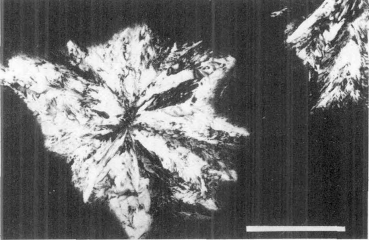Although the A1 - Sb system was chosen for this experiment partly because of the remarkably close melting points of A1 and Sb, we have recently observed a similar laser induced transformation for the system AlAs, and expect the result to be quite qeneral for similar systems.
Although comparatively few irradiations were performed with the ruby laser, and complications due to poor pulse uniformity and reproductibility arose with the dye laser, the two types of irradiation appear to produce more or less the same effects for the same pulse energy.
Observations by TEM and HRED revealed no detectable structure changes (≤0.7% change in amorphous structure factor up to pulse energies (dye only) of s 100 and ~10 mJ/cm2 for supported and unsupported films, respectively. However measurements on supported films at this and lower energies showed both reversible and, with increasing pulse energy, apparently irreversible changes in film conductivity. Reversible but very long duration (up to 107s ! ) photoconductivity effects are known to occur in amorphous elemental semiconductors /5/, and may possibly be related to a redistribution of essentially point defects (i. e. dangling bonds) , although the material remains amornhous.
At pulse energies exceeding those in b) crystallised regions appear in the films for both types of irradiation, fisure I.Observe firstly that the general form of these "stars" indicates very rapid qrowth. Each one is evidently associated with a single nucleation event occuring at the centre followed by rapid qrain growth outwards and terminating in a boundary of randomly oriented microcrystals. Note also that the density of stars, and hence that of the associated nucleation events, is very low compared to volume or surface atomic 3.ensities (tysically 10-9 even for this latter) in the films. Yoreover, a subsequent pulse irradiation has no effect on stars already formed but results in a seemingly random distribution of new ones. Thus the nucleation event seems to be statistically governed rather than associated with any particular type of structural or compositional defect. A further interesting feature is that the star diameter is not only independent of laser power (dye vs. ruby) but is also essentially independent of pulse energy. Neither is it related to the pulse duration which in any case would imply growth rates of several m/s even for the dye laser, a value untypically high for a covalently bonded material.

fig1
There is much current speculation on the mechanisms of laser annealing, particularly as regards the nucleation process. It is perhaps self evident that the first process occuring in a solid subjected to laser irradiation is optically induced electronic excitation and that, at some later time, the energy will have been transferred to the lattice phonons so that the solid is hot in a purely classical sense. The points that are unclear are the time interval involved between these initial and final. states and thus whether, depending on hot electron diffusion rates, the resulting thermal effects can be sufficient to account for the annealing effects observed, whether the very high hot electron densities encountered can result in annealing effects quite independently of any lattice heating, and, more interestingly, whether the annealing observed differs in any way from that expected and found in a purely "thermal" anneal.
Published data for A1 and Sb diffusion in AlSb give activation enerjies of 1.88 and 1.7 eV respectively and suggest the possibility of forming AlSb by solid diffusion through the growing compound layer at temperatures around 1300 K in lps For the crystallisation of a-Ge the temperature "necessary" is rather more difficult to estinate but by comparison with thermal data can be safely assumed to be above % 700 K.
下一篇: 化合物半导体光伏组件参数提取方法